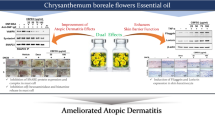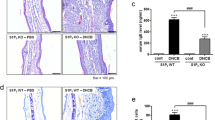Abstract
This work was designed to assess the pharmacological effectiveness as a novel anti-atopic dermatitis remedy of a phopholipid mixture purified from pig lung tissues, named KT&G101, using the BALB/c mouse model of allergic contact dermatitis. Allergic contact dermatitis was induced by applying 2,4-dinitrofluorobenzene (DNFB) epicutaneously onto the dorsal skins of mice, and KT&G101 was topically applied onto the skin areas with the lesions. The topical application of KT&G101 (0.05 ml of 10 mg/ml and 20 mg/ml KT&G101, twice a day for 15 days) decreased the total IgE level elevated in the sera of mice undergoing allergic contact dermatitis. KT&G101 was also able to decrease the 2,4-dinitrophenyl (DNP)-specific IgE level elevated in the sera of the model mice. It reduced the incidences of scratching behaviors in the mice undergoing DNFB-induced allergic contact dermatitis. It attenuated some histopathological changes, such as pustule, epidermal hyperplasia, dermatitis and fibroplasia, while it could enhance the recovery of epidermis, in the damaged skin tissues within a relatively short period after the topical application of KT&G101. KT&G101 lessened the expression of cytokines mRNAs, such as Th1-specific IL-2, TNF-β and IFN-γ, and Th2-specific IL-4, in the mouse skin tissues showing the lesions. In brief, it is concluded that KT&G101 alleviates the symptoms involved in induced allergic contact dermatitis in BALB/c mice.






Similar content being viewed by others
Abbreviations
- AD:
-
Atopic dermatitis
- DEXA:
-
Dexamethasone
- DNFB:
-
2,4-Dinitrofluorobenzene
- DNP:
-
Dinitrophenyl
- DPPC:
-
Dipalmitoylphosphatidylcholine
- PC:
-
Phosphatidylcholine
- PS:
-
Phosphatidylserine
References
Ishimoto T, Takei Y, Yuzawa Y, Hanai K, Nagahara S, Tarumi Y, Matsuo S, Kadomatsu K (2008) Downregulation of monocyte chemoattractant protein-1 involving short interfering RNA attenuates hapten-induced contact hypersensitivity. Mol Ther 16:387–395
Girolomoni G, Gisondi P, Ottaviani C, Cavani A (2004) Immunoregulation of allergic contact dermatitis. J Dermatol 31:264–270
Sebastiani S, Albanesi C, De PO, Puddu P, Cavani A, Girolomoni G (2002) The role of chemokines in allergic contact dermatitis. Arch Dermatol Res 293:552–559
Smith Pease CK, Basketter DA, Patlewicz GY (2003) Contact allergy: the role of skin chemistry and metabolism. Clin Exp Dermatol 28:177–183
Ausaneya U, Kawada A, Aragane Y (2006) Itraconazole suppresses an elicitation phase of a contact hypersensitivity reaction. J Invest Dermatol 126:1028–1035
Man MQ, Hatano Y, Lee SH, Man M, Chang S, Feingold KR, Leung DY, Holleran W, Uchida Y, Elias PM (2008) Characterization of a hapten-induced, murine model with multiple features of atopic dermatitis: structural, immunologic, and biochemical changes following single versus multiple oxazolone challenges. J Invest Dermatol 128:79–86
Jin H, He R, Oyoshi M, Geha PS (2009) Animal models of atopic dermatitis. J Invest Dermatol 129:31–40
Shaheen MA, Mahmoud MA, Abdel Aziz MM, El Morsy HI, Abdel Khalik KA (2009) Sputum dipalmitoylphosphatidylcholine level as a novel airway inflammatory marker in asthmatic children. Clin Respir J 3:95–101
Abate W, Alghaithy AA, Parton J, Jones KP, Jackson SK (2010) Surfactant lipids regulate LPS-induced interleukin-8 production in A549 lung epithelial cells by inhibiting translocation of TLR4 into lipid raft domains. J Lipid Res 51:334–344
Hartmann P, Szabó A, Eros G, Gurabi D, Horváth G, Németh I, Ghyczy M, Boros M (2009) Anti-inflammatory effects of phosphatidylcholine in neutrophil leukocyte-dependent acute arthritis in rats. Eur J Pharmacol 622:58–64
Eros G, Ibrahim S, Siebert N, Boros M, Vollmar B (2009) Oral phosphatidylcholine pretreatment alleviates the signs of experimental rheumatoid arthritis. Arthritis Res Ther 11:R43
Treede I, Bruan A, Jeliaskova P, Giese T, Füllekrug J, Griffiths G, Stremmel W, Ehehalt R (2009) TNF-alpha-induced up-regulation of pro-inflammatory cytokines is reduced by phosphatidylcholine in intestinal epithelial cells. BMC Gastroenterol 9:53
Ramos GC, Fernandes D, Charão CT, Souza DG, Teixeira MM, Assreuy J (2007) Apoptotic mimicry: phosphatidylserine liposomes reduce inflammation through activation of peroxisome proliferator-activated receptors (PPARs) in vivo. Br J Pharmacol 151:844–850
De SR, Ajmone-Cat MA, Nicolini A, Minghetti L (2002) Expression of phosphatidylserine receptor and down-regulation of pro-inflammatory molecule production by its natural ligand in rat microglial cultures. J Neuropathol Exp Neurol 61:237–244
Miller KJ (1985) Effects of temperature and sodium chloride concentration on the phospholipid and fatty acid compositions of a halotolerant Planococcus sp. J Bacteriol 162:263–270
Nielson DW (1986) Electrolyte composition of pulmonary alveolar sub-phase in anesthetized rabbits. J Appl Physiol 60:972–979
Nielson DW, Lewis MB (1988) Calcium increases in pulmonary alveolar fluid in lambs at birth. Pediatr Res 24:322–325
Inagaki N, Shiraishi N, Igeta K, Itoh T, Chikumoto T, Nagao M, Kim JF, Nagai H (2006) Inhibition of scratching behavior associated with allergic dermatitis in mice by tacrolimus, but not by dexamethasone. Eur J Pharmacol 546:189–196
Avgerinou G, Goules AV, Stavropoulos PG, Katsambas AD (2008) Atopic dermatitis: new immunologic aspects. Int J Dermatol 47:219–224
Bae SJ, Lee JB, Takenaka M, Tanaka Y, Shimizu K, Katayama I (2004) Topical glucocorticoid augments scratching behavior in dinitrofluorobenzene-sensitized mice by the induction of substance P. Exp Dermatol 13:780–785
Kawakami Y, Yumoto K, Kawakami T (2007) An improved mouse model of atopic dermatitis and suppression of skin lesions by an inhibitor of Tec family kinases. Allergol Int 56:403–409
Segawa S, Hayashi A, Nakakita Y, Kaneda H, Watari J, Yasui H (2008) Oral administration of heat-killed Lactobacillus brevis SBC8803 ameliorates the development of dermatitis and inhibits immunoglobulin E production in atopic dermatitis model NC/Nga mice. Biol Pharm Bull 31:884–889
Lee SJ, Oh SG, Seo SW, Ahn HJ, Geum D, Cho JJ, Park CS (2007) Oral administration of Astragalus membranaceus inhibits the development of DNFB-induced dermatitis in NC/Nga mice. Biol Pharm Bull 563:1468–1471
Kawashima H, Tateishi N, Shiraishi A, Teraoka N, Tanaka T, Tanaka A, Matsuda H, Kiso Y (2008) Oral administration of dihomo-γ-linolenic acid prevents development of atopic dermatitis in NC/Nga mice. Lipids 43:37–43
Hamasaka A, Abe R, Koyama Y, Yoshioka N, Fujita Y, Hoshina D, Sasaki M, Hirasawa T, Onodera S, Ohshima S, Leng L, Bucala R, Nishihira J, Shimizu T, Shimizu H (2009) DNA vaccination against macrophage migration inhibitory factor improves atopic dermatitis in murine models. J Allergy Clin Immunol 124:90–99
Sun YG, Chen ZF (2007) A gastrin-releasing peptide receptor mediates the itch sensation in the spinal cord. Nature 448:700–703
Kashiwakura J, Kawakami Y, Yuki K, Zajonc DM, Hasegawa S, Tomimori Y, Caplan B, Saito H, Furue M, Oettgen HC, Okayama Y, Kawakami T (2009) Polyclonal IgE induces mast cell survival and cytokine production. Allergol Int 58:411–419
Ott H, Stanzel S, Ocklenburg C, Merk HF, Baron JM, Lehmann S (2009) Total serum IgE as a parameter to differentiate between intrinsic and extrinsic atopic dermatitis in children. Acta Derm Venereol 89:257–261
Inagaki N, Nagao M, Nakamura N, Kawasaki H, Igeta K, Musoh K, Nagai H (2000) Evaluation of anti-scratch properties of oxatomide and epinastine in mice. Eur J Pharmacol 400:73–79
Iguchi T, Kawata A, Watanabe T, Mazumder TK, Tanabe S (2009) Fermented barley extract suppresses the development of atopic dermatitis-like skin lesions in NC/Nga mice, probably by inhibiting inflammatory cytokines. Biosci Biotechnol Biochem 73:489–493
Nagai H, Ueda Y, Ochi T, Hirano Y, Tanaka H, Inagaki N, Kawada K (2000) Different role of IL-4 in the onset of hapten-induced contact hypersensitivity in BALB/c and C57BL/6 mice. Br J Pharmacol 129:299–306
Kim DY, Jung JA, Kim TH, Seo SW, Jung SK, Park CS (2009) Oral administration of Uncariae rhynchophylla inhibits the development of DNFB-induced atopic dermatitis skin lesions via IFN-γ down-regulation in NC/Nga mice. J Ethnopharmacol 122:567–572
Yamada N, Wakugawa M, Kuwata S, Yoshida T, Nakagawa H (1995) Chronologic analysis of in situ cytokine expression in mite allergen-induced dermatitis in atopic subjects. J Allergy Clin Immunol 96:1069–1075
Werfel T, Morita A, Grewe M, Renz H, Wahn U, Krutmann J, Kapp A (1996) Allergen specificity of skin-infiltrating T cells is not restricted to a type-2 cytokine pattern in chronic skin lesions of atopic dermatitis. J Invest Dermatol 107:871–876
Veldhuizen R, Nag K, Orgeig S, Possmayer F (1998) The role of lipids in pulmonary surfactant. Biochim Biophys Acta 1408:90–108
Acknowledgments
The authors are deeply grateful to Mr. Seung-Hyun Song and Ms. Hyun-Jung Kang for their technical assistance.
Author information
Authors and Affiliations
Corresponding authors
Rights and permissions
About this article
Cite this article
Moon, JS., Jeon, BS., Yoon, BI. et al. Topical application of a phospholipid mixture purified from pig lungs ameliorates 2,4-dinitrofluorobenzene-induced allergic contact dermatitis in BALB/c mice. Mol Biol Rep 39, 4237–4247 (2012). https://doi.org/10.1007/s11033-011-1210-7
Received:
Accepted:
Published:
Issue Date:
DOI: https://doi.org/10.1007/s11033-011-1210-7




